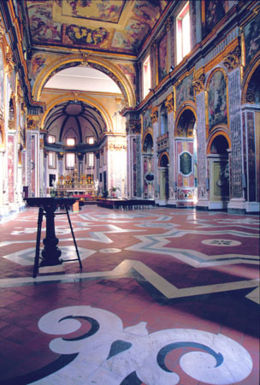
San Paolo Maggiore
Encyclopedia


Basilica
The Latin word basilica , was originally used to describe a Roman public building, usually located in the forum of a Roman town. Public basilicas began to appear in Hellenistic cities in the 2nd century BC.The term was also applied to buildings used for religious purposes...
church in Naples
Naples
Naples is a city in Southern Italy, situated on the country's west coast by the Gulf of Naples. Lying between two notable volcanic regions, Mount Vesuvius and the Phlegraean Fields, it is the capital of the region of Campania and of the province of Naples...
, southern Italy, and the burial place of Gaetano Thiene, known as Saint Cajetan, founder of the Order of Clerics Regular (or Theatines).
History
The Baroque styleBaroque architecture
Baroque architecture is a term used to describe the building style of the Baroque era, begun in late sixteenth century Italy, that took the Roman vocabulary of Renaissance architecture and used it in a new rhetorical and theatrical fashion, often to express the triumph of the Catholic Church and...
church is located on the site of the 1st century temple of the Dioscuri. The front section of the latter, including six columns and triangular tympanum, was visibile until 1688, when it was destroyed by an earthquake. The current church façade includes two columns from the ancient edifice.
The first church dedicated to St. Paul was erected here in the 8th-9th century to celebrate a victory of the Duchy of Naples
Duchy of Naples
The Duchy of Naples began as a Byzantine province that was constituted in the seventh century, in the reduced coastal lands that the Lombards had not conquered during their invasion of Italy in the sixth century...
against the Saracens. This church occupied the area behind the temple's pronaos.
In 1538 the building was obtained by the Theatines
Theatines
The Theatines or the Congregation of Clerks Regular of the Divine Providence are a male religious order of the Catholic Church, with the post-nominal initials "C.R."-Foundation:...
. In the early 1580s, general reconstruction of the building began with the erection of the transept
Transept
For the periodical go to The Transept.A transept is a transverse section, of any building, which lies across the main body of the building. In Christian churches, a transept is an area set crosswise to the nave in a cruciform building in Romanesque and Gothic Christian church architecture...
and the polygonal apse
Apse
In architecture, the apse is a semicircular recess covered with a hemispherical vault or semi-dome...
. This was followed by the nave built by Gian Battista Cavagni. The aisles, designed by Giovan Giacomo di Conforto date from 1625 onwards. As the building was proceeding, it was decorated and embellished, notably by Massimo Stanzione
Massimo Stanzione
Massimo Stanzione was an Italian Baroque painter, mainly active in Naples.Massimo Stanzione was an Italian Baroque painter. Born in Naples in 1586, Massimo was greatly influenced by Michelangelo Merisi da Caravaggio, but what earned him the nickname of The Neapolitan Guido Reni was his...
who painted the nave ceiling. On the occasion of the canonization of the Order's founder, St. Cajetan, Dionisio Lazzaro, unsuccessfully connected the façade with the temple's columns with a wall, causing the building to crumble in 1688.
The decoration continued in the 18th century with, among others, Domenico Antonio Vaccaro
Domenico Antonio Vaccaro
Domenico Antonio Vaccaro was an Italian painter, sculptor and architect, the son and pupil of Lorenzo Vaccaro. Lorenzo was in turn a pupil of Cosimo Fanzago and was part of a large family of artists including Andrea Vaccaro, a pupil of Girolamo Imparato.Domenico Antonio was born in Naples and his...
and Francesco Solimena
Francesco Solimena
Francesco Solimena was a prolific Italian painter of the Baroque era, one of an established family of painters and draughtsmen.-Biography:Francesco Solimena was born in Canale di Serino, near Avellino....
, who re-used marble elements from the ancient edifice for the new pavement and the pilasters of the nave.
The church was severely damaged by an Allied bombing in 1943, which caused the nearly total destruction of Massimo Stanzione's frescoes.
Interior
The interior is on the Latin cross plan. The nave has remains of Stanzione's frescoes depicting Histories of Sts. Paul and Peter. Other frescoes by Solimena can be seen in the sacristySacristy
A sacristy is a room for keeping vestments and other church furnishings, sacred vessels, and parish records.The sacristy is usually located inside the church, but in some cases it is an annex or separate building...
. In the nave there is also a statue of the Guardian Angel (1712) by Domenico Antonio Vaccaro. Notable, especially for their marble decorations, are the Chapels of Firrao di Sant'Agata and the Madonna della Purità, both dating from the 17th centuries. The main altar was sculpted in 1775-1776 to a design by Ferdinando Fuga
Ferdinando Fuga
Ferdinando Fuga was an Italian architect, whose main works were realized in Rome and Naples in the Baroque style.-Biography:Born in Florence, he began to work in that city as a pupil of Giovanni Battista Foggini. In 1717 he moved to Rome, to continue his apprentice studies...
.
Cloister
The cloister was built during the Theatine reconstruction of the late 16th century, occupying the former pagan temple. The vestibule uses columns taken from the former Palaeo-Christian church; the cloister itself has a square plan with, in its center, a well supported by small columns.The frescoes on the walls, one of which was attributed to Aniello Falcone
Aniello Falcone
Aniello Falcone was an Italian Baroque painter, active in Naples and noted for his painted depictions of battle scenes.-Biography:...
, have disappeared.

